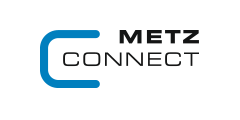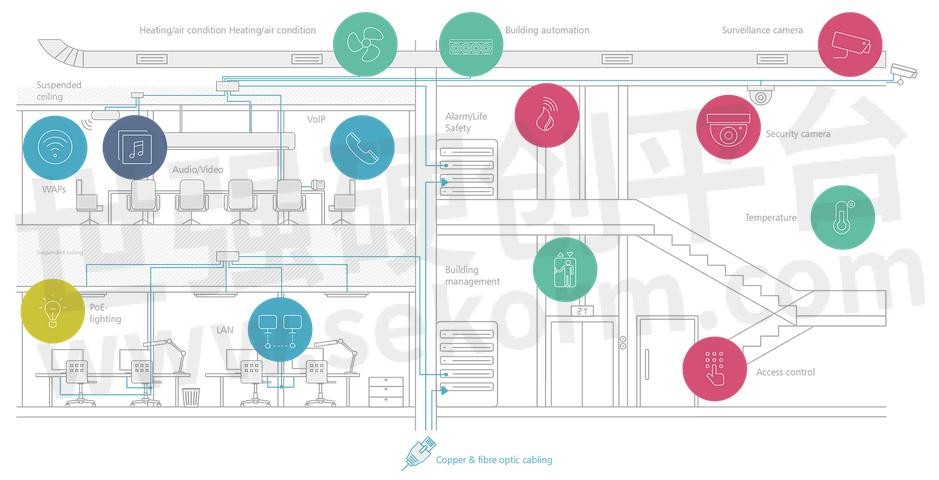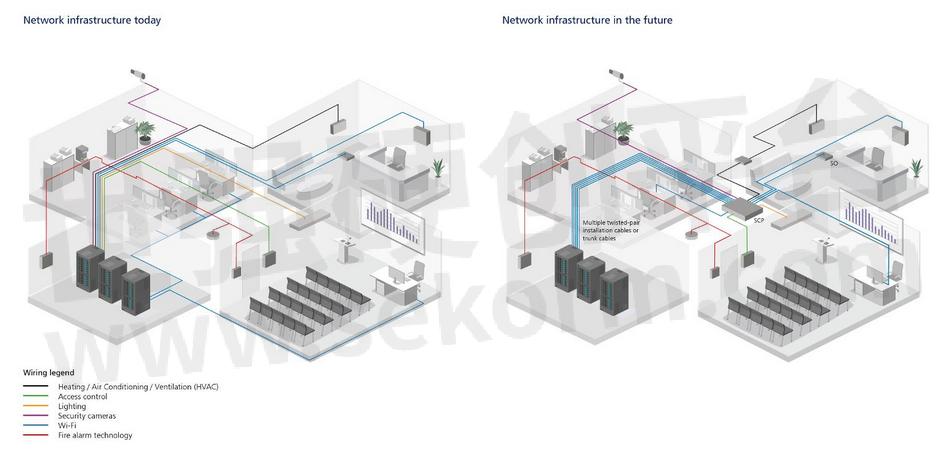Digital Ceiling – Tertiary Cabling in the Ceiling

In many buildings, similar to private residential buildings, it appears that less network cabling based on twisted- pair installation cables and RJ45 connectors is required. The connection for conventional network devices for only a data transmission is either conducted by a wireless network or replaced by fibre optic cabling. On the other hand, there are numerous current and future applications that make copper cabling indispensable through the ability to simultaneously transmit data and power. Last but not least, the Wireless Access Point (WAP) itself needs a connection to the network in order to cover the range of mobile end devices in all areas, provide the full performance and be supplied with power via Power over Ethernet (PoE) at the same time.

PoE technology has been an essential component of network technology for some time. In addition to the data, power is also transmitted via RJ45 connectors and twisted pair cables in order to supply the end devices with power at the same time. The power supply via the network cabling tends into ever higher performance classes, currently up to 90 W. The standardization of power supply in PoE classes is being driven by more and more new devices and applications based on PoE technology. From the IP camera to the lighting, PoE saves part of the cabling through a power supply and simultaneous data transmission, and enables the intelligent building and energy management.
Examples:
Lighting / PoE Lighting
Wireless Networks: Wireless Access Points (WAPs) for WLAN, In-Building Wireless
Wired networks: Voice-over-IP (VoIP) phones, PCs, presentation screens
Security technology: IP surveillance cameras, access control & time recording, fire alarm technology
Sensors (temperature, brightness, humidity, oxygen, etc.)
Controls, control technology (air conditioning, ventilation, heating, elevator, etc.)
Loudspeaker, public address system
Multimedia: HDBaseT (not PoE, but to be considered by PoH following PoE), AVoverIP (depending on device, transceiver, display etc.), intercom systems/ Interco
Networks grow together
More applications for the structured building cabling

The following figure shows what it's all about. On the one hand, the
integration of different languages in the form of transmission protocols
from proprietary solutions or different bus systems into a single
uniform solution – the Ethernet-IP network. On the other hand, the
combination of different transport media into a uniform, widely used
twisted pair cable with RJ45 connectors.
Digital Ceiling – Change in the tertiary cabling
The subject of Digital Ceiling in the field of network
technology can be understood as the digital ceiling to a certain extent.
This means the integration of, for example, intelligent PoE LED
lighting, sensors, customized WAPs for each workstation and other
Ethernet- & Power-over-Ethernet applications in the suspended
ceiling
Basic components for the Digital Ceiling:
Foundation:
Network infrastructure/network
Switches with PoE for data exchange and power supply as a central interface
Network-compatible sensors and actuators with IP interface
Software for data acquisition, analysis, evaluation and control
Devices for various applications:
Intelligent lighting
Air conditioning
ventilation or heating
Security systems
Access control
etc.
Goals and advantages
Consolidation of many building management systems /building automation systems into a single system
Combination of different, proprietary cabling solutions for the respective application/systems to one
New intelligent applications with low-voltage supply
Increasing energy efficiency
Cost savings
Low installation and operating costs
Simple ceiling mounting in the low voltage range
Setup and configuration via software or mobile app
Cabling for data transmission and power supply
Relocation of the network infrastructure to the ceiling
In the current office environment, most network connections are placed near the workplaces in dado ducts and floor boxes. In addition to technology-driven devices with network connectivity, the increasing performance of PoE is also making the network infrastructure increasingly attractive. Many PoE applications are no longer necessarily connected to the wall outlets, the raceway, the table solutions or the floor outlets. These connections are increasingly being moved into the ceiling, e.g. for WAPs, near doors, on presentation walls, for example, for the Digital Signage, as well as outside of buildings on exterior walls or lantern poles. These unconventional connection points may require additional cabling, new cabling solutions, but also new infrastructures.
An alternative to horizontal cabling is the zone cabling in suspended ceilings. Horizontal cabling runs from the floor distributor to a specific area in the building. The service concentration point is located in this area, from where it continues to a service outlet or directly to the end devices. For maximum flexibility and the ideal structure of horizontal cabling with Service Concentration Points, an even division of the floor into cells with the respective Service Concentration Point is recommended.

The background is a more flexible, simpler and more cost-effective change of the cabling when moving, adding or removing end devices. The advantage lies in the shorter distances that have to be rerouted. They are more easily accessible and the intervention as well as interruption times are shorter.
Considering the PoE lighting and other Ethernet and PoE applications, the coverage radius of a zone should not exceed approx. 13 m, which would therefore be a cell of approx. 18 m by 18 m. The background to this is the high number of ports used per service concentration point, which means that over 96 ports are no longer manageable.
Connections can be changed, rerouted or removed at these points. With an increasing number of IP and PoE-enabled end devices, especially in open-plan offices, a long-term saving is achieved through the more flexible and simple changes to this structure. The Service Concentration Point should be at least 15 m away from the floor distributor, and should not exceed the link length of 100 m.

Complete zone cabling via the suspended ceiling
For the current requirements with a view towards the
future, the conventional network infrastructure for workplaces according
to ISO/IEC 11801-2, and the ca-bling infrastructure could be combined
via service con-centration points for distributed building services
ac-cording to ISO/IEC 11801-6.The following figure shows the separate,
application specific cabling and cabling with service concentration
point for Wi-Fi applications.
A complete horizontal cabling via an SCP in the suspended ceiling could look like the depiction in the following figure. The merged applications are depicted in the network cabling through an SCP. Most applications in the ceiling could be solved as with Wi-Fi cabling and the individual workstations could be wired via cable ducts, columns or on the walls all the way up to the wall outlet.
- +1 Like
- Add to Favorites
Recommend
- Upgrade Your Connectivity with Kinghelm RJ45 Connectors KH-RJ45-56-8P8C-D
- Kinghelm RJ45 Connectors KH-RJ45-56-8P8C-D-T: The Ultimate Solution for Reliable Connectivity
- RJ45 Connectors with Surge Protection UNSxxx Has a Built-in Network Transformer, Which Can Realize the Isolation of Network Signals
- Enhancing Network Performance with CAT6A RJ45 Connectors
- RJ45 Connector for PoE+ Cabling Solution Can Provide up to 90W of Power Supply | Rosenberger
- LINK-PP‘s Magnetic RJ45 Connectors Empowers Industrial Automation
- TE Connectivity’s Angled RJ45 Connectors Exceeding Data Rates of 1Gb/s and Decreasing PCB Assembly Costs Used for Cat6
- Enhance Your Network with Kinghelm RJ45 Connector KH-RCH56-8P8C-D
This document is provided by Sekorm Platform for VIP exclusive service. The copyright is owned by Sekorm. Without authorization, any medias, websites or individual are not allowed to reprint. When authorizing the reprint, the link of www.sekorm.com must be indicated.





























































































































































































































































































































































































































































































































































































































































































































































































































































































